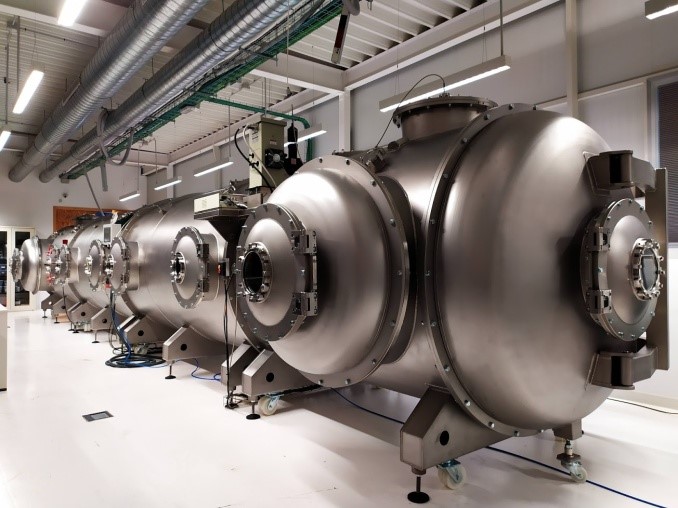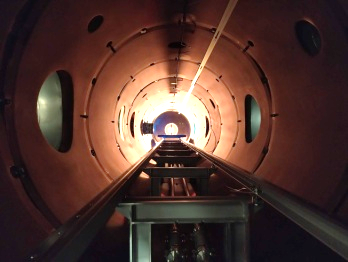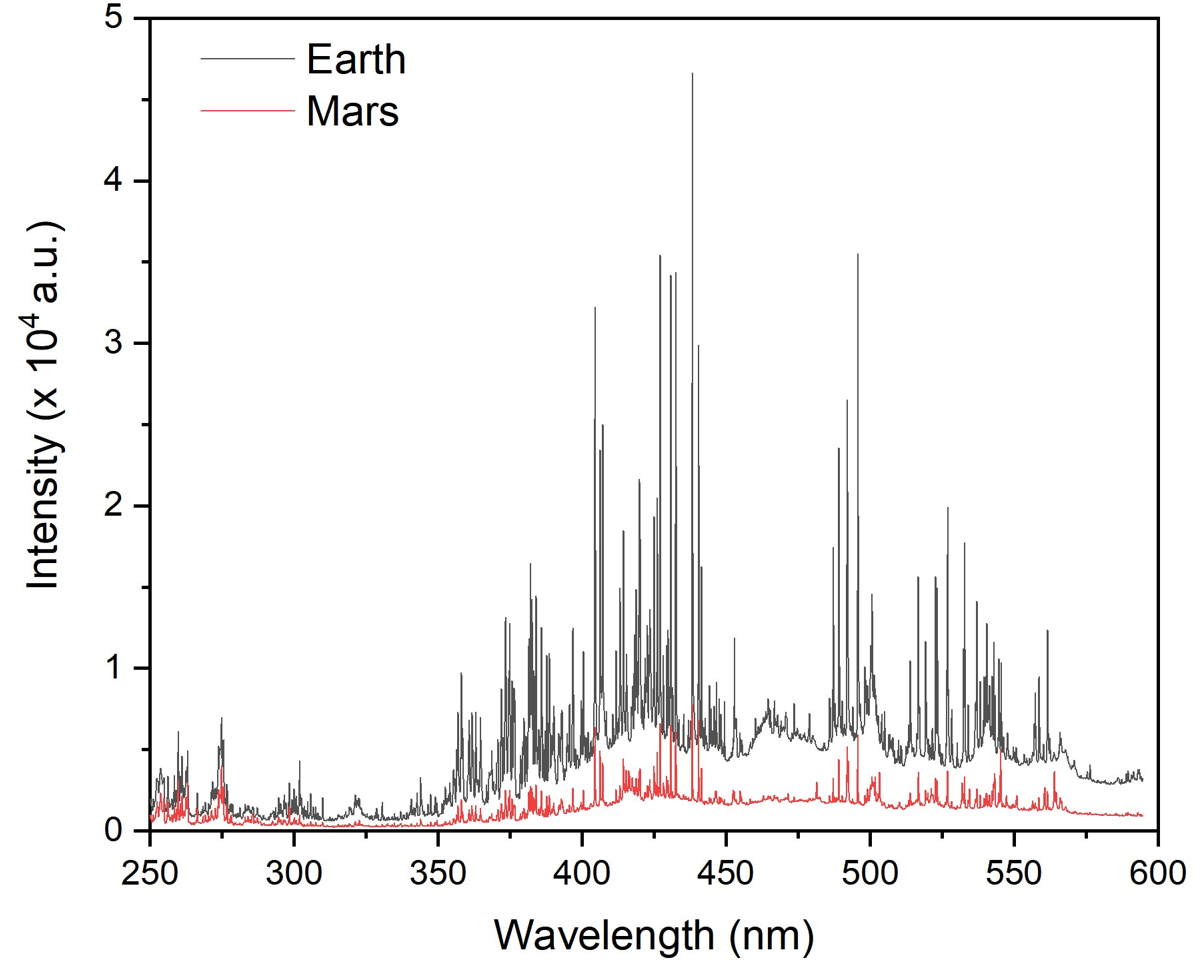A multipurpose thermal vacuum chamber for planetary research compatible with stand-off laser spectroscopies
- UMALASERLAB, Departamento de Química Analítica, Universidad de Málaga, 29010 Málaga (España)
The availability of thermal vacuum chambers (TVC) represents a need in today´s planetary research. A TVC must be capable of operate under representative conditions (temperature, gas composition, pressure, radiation flux …) of space exploration targets, but also have an useful volume compatible with the performing experiments and the testing of equipment under mimicked scenarios.
Stand-off spectroscopies and imaging techniques have gained a proper niche within the modern tools in remote compositional analysis for space exporation using rovers. Laser-induced breakdown spectroscopy (LIBS), Raman spectroscopy, time-resolved laser-induced fluorescence (LIF) and laser-induced shockwave acoustics are tools currently installed and used at the Perseverance rover in the seek of understanding of mineralogy and geochemistry of Mars as they obtain real-time information at distances up to 12 meters. The convenience of a TVC capable of performing stand-off spectroscopies under the current analysis range is evident as it allows reproducing the results obtained in the rovers, gaining insights about data treatment and data modelling, and also anticipating experiments on Earth before being commanded.
This abstract details the TVC designed and installed at UMALASERLAB to serve the astrochemical community. With a length of 12 meters and an useful internal diameter of 1.6 meters, the chamber operates in a temperature range between 200 K - 400 K and can be oil-free pumped down from atmospheric pressure to 10-4 mbar in the current configuration. Additional upgrades may extend the pressure range up to the 10-6 mbar range. Such figures and dimensions turns the TVC of UMALASERLAB a powerful and versatile tool for space-related studies in chemistry, biology and engineering.

Fig. 1. Panoramic view of the simulation chamber at UMALASERLAB facilities.
The TVC at UMALASERLAB (Figure. 1) is an stainless-steel cylinder of ca. 22 m3 made of four independent on-wheels units. The external cylinder-shaped vessel is made in 304L stainless steel. All the internal surfaces are electropolished. The vacuum vessel ensures an overall leak range < 1x10-6 mbar.l/s. Such value is exclusively limited by the VitonTM O-rings connecting the four units of the cylinder as well as the all the different flanges of the 50 auxiliary ISO-K and ISO-KF ports.
The interior of the chamber is manned accessed by two hinged-doors at the ends of the chamber with a diameter of 1,6 meters, as well as by two lateral hinged-doors with a 1 meter diameter. The four doors are equipped with large hinged DN 500 ISO-K flange that included a DN 250 ISO K inspection windows.
The chamber thermal jacket is made of two thin TIG welded stainless steel 304 L sheets according to a “spot-grid” figure. An air-blowing pressurization applied after the welding, causes a controlled blistering creating a set of channels for the cooling fluid, that covers the entire surface of the heat exchanger ensuring very good temperature uniformity, savings of raw materials, greater efficiency in heat transfer and lower thermal inertia. The temperature changing rate of the chamber is 1 ºC/min.
The internal surface of the shroud is black-painted with a special enamel to improve the thermal emission of the surface itself and maximizing light absorption (> 95 % at any angle) to reduce flares os ghost effects in the recorded spectra. The painting exhibit a degassing rate < 10-6 mbar.-l/s.

Fig. 2. (Top) Detail of the rails crossing the entire length of the chamber. (Middle and bottom) Details of the two lateral ports of the chamber allowing the loading of an optical table for laser spectroscopy experiments on one side (middle) and the loading of an anechoic chamber on the other end (middle).
Two stainless steel rails placed along the major axis of the cylinder allows the displacement of three grid patterned threaded plates fixation along the interior of the chamber (Figure 2, top). A second set or telescopic rails allow the plates to get out of the chamber for loading and handling (Figure 2, middle and bottom). The plates are placed directly on rails supported by the vessel, in order to avoid any mechanical stress on the shroud. In the loading position outside the chamber, the plates allow a maximum weight of 70 kilograms. For experiments demanding deep UV illumination, a fiber-optic connected to a high-power Xe lamp provides illumination conditions similar to those at Mars surface in the UV-A, UV-B and UV-C spectral regions over an area of 1 cm2.
A graphic user interface allows local and remote visualization, control and data logging of the vacuum pumps, the cooling/heating system, the pressure gauges, the thermocouple gauges, and the mass flow controllers for gas mix load in the chamber.
Different Mars-geochemistry related experiments are being conducted in the TVC with the aim of finding different ways to infere as much information as possible from the different stand-off techniques available. In particular, data fusion algorythms combining Raman, LIBS and the associated acoustic signals have been succesfully implemented for the categorization of soils, rocks and mineral phases of interest in Mars exploration.

Fig. 3. Stand-off LIBS spectra of pyrite sample placed 12 meters away the laser head under standard Earth conditions (black line) and Mars-like atmospheric conditions.
As a performance test, Figure 3 shows two LIBS spectra taken under Earth and Mars-like conditions of a pyrite. The commercial laser (l: 1064 nm) and spectrometer were external to the chamber due to non-compatibiity of the electronics with the temperature. The rest of the elements were placed inside the chamber. The sample was placed inside the TVC 12 meters away the laser head under standard standard pressure, gas composition and temperature Earth conditions (black line) while the red line represents the same sample analyzed under Mars-like atmospheric conditions (10 mbar CO2, -10 ºC). In both examples, 100 accumulated shots were averaged. At a set laser energy of 40 mJ/pulse, the spot diameter was 500 microns.
How to cite: Álvarez-Llamas, C., Purohit, P., Moros, J., Lucena, P., Vadillo, J.-M., and Laserna, J.: A multipurpose thermal vacuum chamber for planetary research compatible with stand-off laser spectroscopies, Europlanet Science Congress 2022, Granada, Spain, 18–23 Sep 2022, EPSC2022-1234, https://doi.org/10.5194/epsc2022-1234, 2022.

